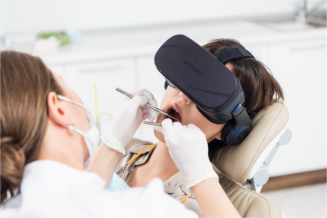
July 18, 2023, 6:50 am
In recent years, advancements in dental technology have revolutionized the field, offering innovative solutions that improve both the clinical outcomes and overall patient experience. From diagnosis and treatment planning to actual procedures, these cutting-edge technologies have the potential to transform dental visits into more comfortable, efficient, and personalized experiences.
- Improved Diagnostic Capabilities:
Dental technology has greatly enhanced diagnostic capabilities, enabling dentists to identify and address oral health issues more accurately and efficiently. Advanced imaging techniques, such as digital radiography and cone beam computed tomography (CBCT), provide detailed 3D images of the teeth, bones, and soft tissues, allowing for more precise diagnosis of conditions like cavities, fractures, and impacted teeth. These technologies not only reduce patient exposure to radiation but also aid in better treatment planning, resulting in more targeted and effective care.
- Enhanced Treatment Planning and Communication:
Technological advancements have revolutionized treatment planning and communication between dental professionals and patients. Computer-aided design and computer-aided manufacturing (CAD/CAM) systems enable dentists to create highly accurate digital impressions, design restorations (e.g., crowns, bridges, veneers) chairside, and produce them in a single visit using in-office milling machines. This eliminates the need for traditional messy impressions and multiple appointments, providing patients with faster, more convenient treatment options.
Furthermore, intraoral scanners allow for efficient and comfortable digital impressions, enhancing patient comfort and reducing the time spent in the dental chair. Dentists can use these digital scans to explain treatment plans visually, involving patients in the decision-making process and ensuring they have a clear understanding of their oral health needs and the proposed procedures.
- Minimally Invasive Techniques:
Technological advancements have led to the development of minimally invasive techniques, which can significantly improve the patient experience. Laser dentistry, for example, offers precise and gentle treatment options for procedures such as gum disease treatment, cavity removal, and soft tissue surgeries. Lasers minimize discomfort, reduce bleeding, and promote faster healing, leading to a more comfortable and pleasant experience for patients.
Similarly, air abrasion technology utilizes a stream of tiny abrasive particles to remove tooth decay or prepare teeth for restorations without the need for traditional drilling. This technique is often painless and reduces the need for local anesthesia, making it an excellent option for patients who may be anxious about dental procedures.
- Virtual Reality and Sedation Dentistry:
For patients who experience dental anxiety or fear, technology has introduced innovative solutions to improve their experience and alleviate stress. Virtual reality (VR) headsets can be used to create immersive environments that distract patients during procedures, reducing anxiety and discomfort. VR technology can transport patients to serene landscapes or engaging scenarios, effectively redirecting their focus away from the dental chair.
Sedation dentistry, another valuable advancement, involves the use of medication to induce a state of relaxation and tranquility in patients. This approach helps individuals with dental phobias or extensive treatment needs to undergo procedures without fear or discomfort, resulting in a more positive and stress-free experience.
Dental technology has had a profound impact on the patient experience, transforming dental visits into more comfortable, efficient, and personalized experiences. From improved diagnostic capabilities and enhanced treatment planning to minimally invasive techniques and anxiety-alleviating technologies, these recent advancements have revolutionized the field of dentistry. By embracing and leveraging these technologies, dental professionals can deliver superior care, foster patient satisfaction, and ultimately, create a positive and lasting impression on their patients' oral health journey.
